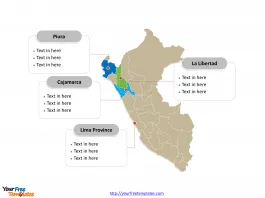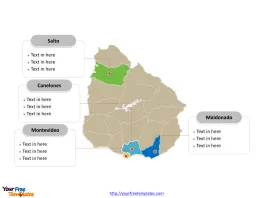The Bolivia Map Template includes two slides. Bolivia map with nine departments, labeling with major departments, La Paz, Santa Cruz, Cochabamba, and Potosí. Bolivia map labeling with national capital and major cities, Santa Cruz de la Sierra, La Paz, Cochabamba, Oruro, and Sucre.
Bolivia, a landlocked country in South America, shares borders with Argentina, Brazil, Chile, Paraguay, and Peru. It is characterized by the rugged Andes Mountains, a highland plateau, and lowland plains of the Amazon basin. The country’s population is estimated to be around 11.8 million people, comprising various indigenous groups and ethnicities.
Bolivia’s economy is a mixed system with elements of both private freedom and centralized economic planning. It heavily relies on its natural resources, including lithium, tin, natural gas, and petroleum, and faces challenges such as income inequality and access to basic services like clean water and sanitation. Bolivia is a member of the Andean Community and strives to safeguard Global South interests through partnerships with countries like China. The nation’s demographics, geographic features, and economic structure play a significant role in shaping its regional and global interactions.
Slide 1, Bolivia map labeled with capital and major cities.
Its capital and largest city is Sucre and Santa Cruz de la Sierra respectively, other major cities including La Paz, Cochabamba, and Oruro.
Capital and Major Cities on Bolivia map
La Paz La Paz, the de facto capital of Bolivia, is the highest capital city in the world, nestled in the Andes Mountains. It serves as a major political and cultural center, featuring diverse indigenous influences and a stunning natural backdrop. La Paz is known for its indigenous markets, historic landmarks, and governmental institutions, making it a vital hub in Bolivia’s administrative and cultural landscape.

Santa Cruz de la Sierra Santa Cruz de la Sierra, often referred to as Santa Cruz, is Bolivia’s largest city and a key economic powerhouse. Situated in the eastern lowlands, it is a vibrant center of commerce, industry, and agriculture, playing a pivotal role in Bolivia’s economy and regional trade.
Cochabamba Cochabamba, located in the Cochabamba Department, is a central city known for its pleasant climate and fertile valleys. It is an important industrial and cultural center, contributing significantly to Bolivia’s agricultural and manufacturing sectors.
Oruro Oruro, a city renowned for its annual carnival and mining heritage, is situated in the high plateau region. It is a cultural hub and a center for mining activities, showcasing Bolivia’s rich tradition and economic diversity.
Sucre Sucre, the constitutional capital of Bolivia, holds great historical and architectural significance. It is a UNESCO World Heritage site, known for its well-preserved colonial architecture and as a center for education and law in Bolivia.
Slide 2, Bolivia map labeled with major administration districts.
Bolivia is a country with nine departments; they are Pando, La Paz, Beni, Oruro, Cochabamba, Santa Cruz, Potosí, Chuquisaca, and Tarija. Every individual political subdivision is an editable shape.
Major Departments on Bolivia map
La Paz La Paz is one of the most prominent departments in Bolivia, housing the de facto capital and encompassing diverse landscapes, from the high Andean plateau to the Amazon rainforest. It is a region of immense cultural richness and economic diversity.

Santa Cruz Santa Cruz is Bolivia’s largest department and a major agricultural and industrial center. It is known for its vast plains and tropical climate, playing a crucial role in the country’s agribusiness and trade activities.
Cochabamba Cochabamba is a central department known for its agricultural productivity and cultural heritage. It is a region with a strong indigenous presence and is recognized for its culinary traditions and historical significance.
Potosí Potosí, historically renowned for its silver mines, is a department with a rich mining legacy and colonial heritage. It is a region of great historical importance and natural beauty, contributing to Bolivia’s mining and tourism sectors.
In conclusion, Bolivia’s capital, major cities, and departments represent the country’s diverse cultural heritage, economic activities, and geographic characteristics. From the political center of La Paz to the economic powerhouse of Santa Cruz, each location plays a distinct role in shaping Bolivia’s identity and regional dynamics.
Looking for Premium maps, please visit our affiliate site: https://editablemaps.com/ or https://ofomaps.com/
Size: 109K
Type: PPTX
Aspect Ratio: Standard 4:3
Click the blue button to download it.
Download the 4:3 Template
Aspect Ratio: Widescreen 16:9
Click the green button to download it.
Download the 16:9 Template


